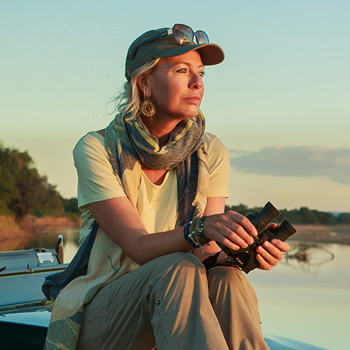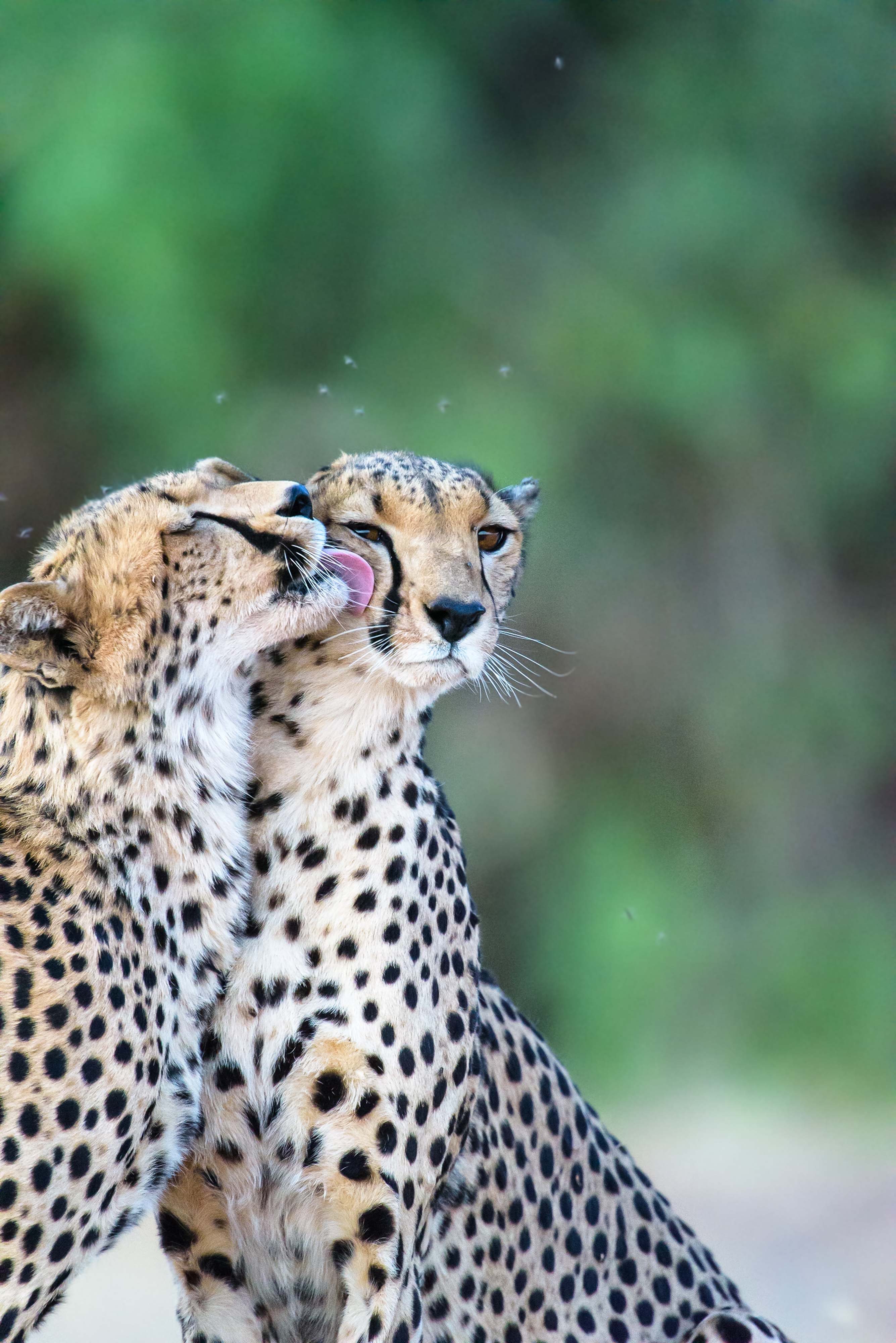Margot Raggett
Margot Raggett left a corporate career in PR in London in 2010, in order to concentrate on her love of wildlife photography. She was a regular 'Photographer in Residence' at Entim Camp in the Maasai Mara for a number of years and was also leading photographic safaris, before everything changed again for her when she saw a poached elephant in late 2014. So moved by that incident, in 2015 she founded the Remembering Wildlife project, a 'live-aid' moment for wildlife photographers coming together for a fund-raising book entitled Remembering Elephants.
Location: Kenya, East Africa
Date: 5th September 2022


Heroes of the extreme
An interview with Margot Raggett.


Margot Raggett in Kenya, photographing zebras.
Meeting Margot
The journey to the extraordinary.
Your biography on your website basically says that you met photography almost by chance. Can you tell us how did you become a professional?
I fell in love with wildlife and safaris many years before picking up a camera! In the 2000s, I worked in PR in London and used all my spare cash to book safaris to Africa, as I had become totally addicted to being in nature. It was when I inadvertently signed up to a photography-based safari in 2010 that everything changed for me. It was a trip to see Kenya’s ‘Great Migration’ led by Jonathan & Angela Scott and it was only a few days before I went, that I realised I was supposed to bring a camera. I bought a cheap kit camera & lens and headed to Kenya. It turned out that camera was no good at all for wildlife (it was a very short lens) but nonetheless, I was totally inspired by Jonathan & Angela’s photography. When I got home, I immediately upgraded my gear and signed up for a course at the London School of Photography to learn the basics and I’ve never looked back. For a few years I went on as many photographer-led trips as I could, to learn from the best and then in 2012, agreed a deal to work as a Photographer in Residence at a camp in the Maasai Mara called Entim Camp. At that point I started selling my photos and attracting followers on social media.




It was in 2014 that everything changed for me once again. I had been working as a resident photographer in Kenya at that point for about three months a year, for three years, and it was at the end of one of those stays that I travelled to Laikipia to visit a friend. We were woken very early in camp by the sound of hyenas going crazy and at first light, went to investigate. What I saw changed my life, It was an elephant who has died from a poisoned arrow, likely poachers had shot him but he’d got away, only to die a slow, painful death over the next few days. The hyenas had started to eat his body and the sight - and the smell - was so shocking. I came to realise that poaching and the many other threats that wildlife faces are often hidden away from tourists and as a result, many like me at that point, had any idea how bad things really are. I was incredibly angry and upset and resolved to channel those emotions into something positive. That was the trigger for me to start work on what I thought would be a one-off book on elephants, to raise awareness about poaching and funds for projects working to protect elephants. I started to approach wildlife photographers I’d met in the field and invited them to donate an image each and it took off from there. 18 months later, Remembering Elephants was published. It sold out in 2 months and raised more than £100,000 and without me knowing it, a series was born. We’ve published five more books since (Remembering Rhinos, Remembering Great Apes, Remembering Lions, Remembering Cheetahs and Remembering African Wild Dogs) and the 7th in the series, Remembering Bears, will be published in October 2022. More than $1.2m USD has been raised by the series for conservation so far. Over 200 photographers have now contributed to the series and producing and steering it, has become my life’s work. Nowadays I spend far less time in the field taking traditional wildlife pictures like before but rather, I spend more time visiting the projects we are able to support with our funds, so I can see how our money is making a difference.
Your work has a very elegant voice, how did you develop it?
I think every photographer is driven in their style by what appeals to them and maybe also, the work is a reflection of them as an individual. In my case, I’m most often attracted to images showing emotion, whether it is a mother greeting her cub, or a tender moment between siblings. Over time I’ve become more selective in what I want to capture and it is those unique ‘moments’ that can never be repeated, which are the ones I strive for.
What is your highest ambition as a professional photographer?
To use photography to give wildlife a voice it otherwise does not have, is our greatest opportunity and obligation as photographers I think. Gone are the days when people can morally just ’take’ from the wildlife by selling images of it with no return. If we don’t act now, there is a good chance a lot of the wildlife we still see today will be gone within a couple of decades. So I believe it is incumbent on all wildlife photographers to tell the story of that animal and the challenges it faces, rather than pretend there is still some utopia out there where any creature is unaffected by man’s impact.


Margot's gear
Ensure those moments are never compromised.
What is so special about the Gitzo equipment that made you choose it among all the others?
The lightness and sturdiness of the Gitzo gear is key. My camera gear already takes up so much weight that it is essential my tripod and head are light but can handle the weight. Plus, it needs to perform in all conditions.
In terms of equipment, what is the gear you usually go to your expeditions with?
I shoot on Nikon, generally on a D850 with a 400mm f/2.8 prime lens and various extenders and smaller lenses too.


Margot Raggett photographing zebras with the Fluid Gimbal and Systematic Tripod.
Framing the extraordinary
Capturing award winning photographs.
Tell us about the project Remembering Wildlife and the new book you’re releasing.
Remembering Wildlife is the collective name for the series of books I created, after being prompted to act after seeing a poached elephant in Northern Kenya in 2014. At the time, I was so upset by the futility of that death that I began asking fellow wildlife photographers if they would contribute to a fundraising book to raise money for anti-poaching work. Their response was unanimous and Remembering Elephants, by ‘Wildlife Photographers United’ was published in September 2016 with images donated by 65 of the world’s top wildlife photographers. Such was the success that Remembering Rhinos was quickly announced and launched in 2017, once again to critical acclaim. Remembering Great Apes, the third book in the series, was published on 15th October 2018 featuring images donated by 72 photographers and a foreword by Dr Jane Goodall. On 14th October 2019 we launched the fourth book in the series Remembering Lions featuring images by 74 photographers. We published Remembering Cheetahs, featuring images donated by 75 photographers, on 12th October 2020 and then Remembering African Wild Dogs in November 2021. Despite all of the challenges of the last two years, these latest lockdown books have sold remarkably well, further helped by distribution deals in the US, Canada and South Africa. Together, the series has now sold more than 33,000 books and distributed more than £947,000 GBP / €1 million euros/ $1.22 million USD to 56 different conservation projects in 24 countries across Africa and Asia.
Remembering Bears will be the 7th book in the series and is due to be published in October 2022 (I am on press in Verona, Italy as I type) and features images by 88 wildlife photographers, taking the number we’ve now worked with on the series to 234. This is the first book in the series which features non-African based wildlife, as I felt it was time to reflect species from elsewhere in the world and it features all eight extant types of bear. What’s interesting is that so many of the threats that bears face are the same as all of the other animals we’ve covered so far - namely, it is always humans which are the problem! As there are more and more people on this planet and less and less space for all other species, conflicts will only increase and unless we take action now, there may not be any wildlife left within a few generations. That’s the idea behind the title of the books - inspired by a quote from Sir David Attenborough - that in the future, if we don’t act now, we might only be Remembering all of these animals in books.
Be inspired
Experience wildlife through the eyes of Margot.

























